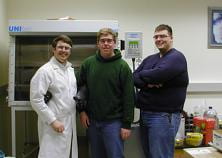
Currently, the McLauchlan Group research interests lie with vanadium coordination chemistry, with one conceived project focused on materials and catalysis and another involving bio-mimetic activity of V complexes. These topics have been chosen with student interests and education in mind in that they each expose students to a variety of synthetic and characterization techniques while pursuing some intriguing chemical problems. A brief summary of each project follows. Characterization techniques and required instrumentation as well as a brief summary follow the research plans.
Molecular Vanadium-Phosph(on)ates as Oxidation Catalysts

Vanadium is used quite extensively for oxidation catalysis– specifically for sulfuric acid production. Recently, it has been demonstrated that a vanadyl phosphate catalyst transforms C4H10 to maleic anhydride. Can simple reactions be used to make vanadium phosphates and phosphonates for catalytic use? Our group has been working to make Vanadium phosphonate complexes by employing tridentate ligands to “dimensionally reduce” the structures from extended structures to molecular species. These new vanadium phosphate or -phosphonate complexes may have unusual frameworks and we are studying their electrochemical and catalytic properties.
Biomimetic Uses of Vanadium: Insulin-Enhancing V Complexes
Over the past 25 years, a number of vanadium complexes have been shown to be “insulin mimetic”, that is, to diminish blood glucose levels, when administered as therapeutic agents. More recent studies have shown that these complexes do not actually mimic insulin, but merely enhance the effects of the small quantities of insulin that are present. A variety of coordination complexes containing combinations of N/S/O donor sets all seem effective in reducing blood glucose levels regardless of which donor set is employed. Complexes with ligand systems including dithiolenes (S/S), cysteine-amines (S/N), picolinates (N/O), catecholates (O/O), salen (N/O), and guanidine (N/N) have all been employed, all almost exclusively with V(IV) and V(V) systems. The disparate nature of the ligands suggests that it is the metal center and not the ligand that is playing the dominant role in therapy. It is the goal of this work to gain an understanding of the oxidation under physiological conditions of a series of V(III) species with well-understood ligands and then implement the acquired knowledge in the synthesis of vanadium coordination complexes to be studied for bio-mimetic insulin-enhancing properties. We have synthesized a number of complexes so far and have been investigating their alkaline phosphatase inhibition properties as prima facia evidence for the ability to be useful as insulin enhancing agents. We have been studying the systems at varying pH and temperature. Promising candidates can then be investigated using the more physiologically relevant protein phosphatases.
Funding
Our research is currently supported by:
